Throughout his/her career, every single nurse will run into moral conundrums in a variety of difficult patient care situations. Maleficence is the deliberate infliction of an unfavorable deed or result on another person or a group, whereas non-maleficence means that a person genuinely works toward a beneficial outcome for those with whom they come into touch. Here we will see about What Is An Example Of Non-maleficence In Nursing?
Non-maleficence in the field of healthcare, and mainly nursing, places a premium on an ethical ideal. Their many examples of non-maleficence in nursing, they can be applied in various ways like difficult and demanding situations. The following list is not exhaustive and includes other situations in which nurses may apply the non-maleficence principle.

Significance of Non-maleficence in nursing
Non-maleficence is an important component. Since it provides guidelines while making crucial judgments. This is unquestionably pertinent when making decisions are made more difficult by competing opinions, difficult surroundings, or disagreements.
Nursing has its code of ethics to guarantee that people have clear guidelines to follow when selecting what actions to take and which ones to overrule, like many other professions.
One of the most important and applicable principles of the nursing code of ethics is non-maleficence, sometimes known as the principle of no harm. The following examples illustrate how to use this nursing ethical principle:
Deciding on a path of action when competing values are there
The advocacy for the many therapeutic interventions that are accessible to patients by nurses and other medical professionals must be careful not to be influenced by their ideas. A conflict of values may arise when someone’s attitudes toward family planning or contraception are influenced by their religious convictions towards marriage and sexuality.
Helping patients in coming to their accomplished judgments
Treatments such as chemotherapy, Dialysis, surgery, or a particular medication can all be a major concern to a patient. The advantages and disadvantages of various therapy, as well as what might occur if none are used, must be fully explained to patients by nurses.
Assisting patients whose decisions cannot be made for themselves
Although they may have family members or other caretakers, many patients might not have anybody else to make decisions for them. Sometimes these decisions must be made on behalf of patients by healthcare professionals. Other patients, such as those who are unconscious or too young, such as NICU patients, are not capable of making decisions for themselves
Examples of Non-maleficence in nursing
v Full thickness burns were sustained by a 12-year-old patient on various portions of her body, making her struggle with both her emotional well-being and several daily tasks. Following the incident, the patient developed depression.
Her treatment plan, includes, performing functional exercises known as physiotherapy, receiving massage therapy, and performing stretches in addition to active motions of the damaged joints to improve their mobility of the joints. The patient, on the other hand, found the treatment boring and only sometimes gave it their entire attention.
Due to the excruciating passive stretches, she also developed a fear of therapy sessions because she associated them with pain.
The patient informed the nurse that she experiences tremendous agony and discomfort as a result of the treatment plan every single day of the week. The nurse is aware of the advantages of passive stretches in preventing contractures and preserving range of motion in affected joints.
In conclusion, even though the patient finds the stretches to be excruciatingly painful, especially at her age, the treatment itself is not fundamentally wrong and the only goal is to produce a favorable outcome.
Understanding Non-maleficence between nurses and patients
Healthcare professionals must strike a balance between the principle of non-maleficence and the evaluation of therapies for medical problems. All nursing and medical actions are intended to enhance the patient’s overall health and welfare.
Providing suggestions based on the patient’s best interests is the cornerstone of professional interactions between patients and healthcare professionals, particularly nurses. For patients to make an informed decision, healthcare professionals must always communicate any potential drawbacks of recommended interventions.
Many medical procedures carry a risk of adverse effects and inconvenience. The decision on when these effects cross the line into harm must be made by both healthcare professionals and patients.
The working environment of non-maleficence
It’s crucial to keep the principle of non-maleficence in mind in working with any member of the healthcare team. Not just patient care, but all aspects of healthcare can be guided by the non-maleficence concept.
Providing a secure and healthy workplace for other healthcare team members is a moral obligation for professionals in the health field. In such an environment, concerns can be voiced without worrying about reprisals.
Conclusion
In conclusion, a nurse has to maintain the patient’s safety requirements that they refrain from exposing the patient to danger, which is in direct conflict with the idea of non-maleficence, or not harms. This ethical premise is very important to all nursing decisions, especially under difficult, and demanding circumstances. Nurses are required to think about both the short-term and long-term impacts of potential therapies too. Through this article we have learned about What Is An Example Of Non-maleficence In Nursing?